2013 Conference Proceedings - University of Nevada, Las Vegas
2013 Conference Proceedings - University of Nevada, Las Vegas
2013 Conference Proceedings - University of Nevada, Las Vegas
- No tags were found...
You also want an ePaper? Increase the reach of your titles
YUMPU automatically turns print PDFs into web optimized ePapers that Google loves.
MethodologyAs a starting point for investigating how middle and secondary mathematics teachers that arenovice combinatorialists categorize and conceptualize various problem types, two focus groups(e.g., Berg & Lune, 2012) were conducted (N=3 and N=4). The focus groups were conducted inconjunction with a graduate mathematics education course; all seven participants in the focusgroups were practicing middle and secondary teachers with less than 6 years teaching experienceand were enrolled in the course. The focus groups were preceded by a brief introduction tocombinatorics problems in the course. While the middle and secondary teachers in the coursehad various mathematical backgrounds, none <strong>of</strong> the focus group participants had completed acourse in combinatorics or discrete mathematics, making them novice combinatorialists.The brief introduction (~90 minutes) in the course consisted <strong>of</strong> two parts: 1) overt instructionon the addition principle; the multiplication principle; factorial notation; and dividing outextraneous solutions when order is irrelevant, including theæ nöçè k÷ønotation; and 2) approaches andsolutions to six combinatorics problems, which were selected as being relatively commonexamples <strong>of</strong> the four types <strong>of</strong> problems from textbooks and other literature. The six problems(see Table 2) were presented to students as a way to expose them to various strategies for solvingcombinatorial problems; no structural characteristics <strong>of</strong> problems (e.g., order matters, repetitionallowed) were mentioned and no connections between “types” <strong>of</strong> problems were discussed.Table 2Description <strong>of</strong> Combinatorics Problems presented to participants with solutionsName Description Type & SolutionSubsetIf 10 people are at a party and everyone shakes hands with everyone else,Handshakehow many total handshakes are given?PasswordHot DogsVotingStatesVowelA password has to be 8 characters long and can use any <strong>of</strong> the 26 letters orthe 10 digits (not case sensitive). How many different passwords are there?Hot dogs come in 3 varieties: Regular, Chili, Super. How many differentways are there to purchase 6 hot dogs?Two candidates are running for a club election. In the end, candidate Agets 4 votes and candidate B gets 5 votes. The moderator <strong>of</strong> the club,however, reads each vote out loud in order. How many different wayscould he read out the votes?How many different “words” can you make with the letters (nonsensewords count) in TEXAS? How about in MISSISSIPPI?You are creating 5 letter words that CAN repeat letters. How many wordsare there that have at least one vowel?æ10öçè 2 ÷øSequence36 8Multisubsetææ3ööçèçè 6÷ø ÷ø= æ 6 + 2 öçè 2 ÷øSubsetæ 9öçè 4 ÷ ø= æ 9 öçè 5 ÷øArrangement5!11!4!4!2!Sequence26 5 - 21 5<strong>Proceedings</strong> <strong>of</strong> the 40 th Annual Meeting <strong>of</strong> the Research Council on Mathematics Learning <strong>2013</strong> 147




